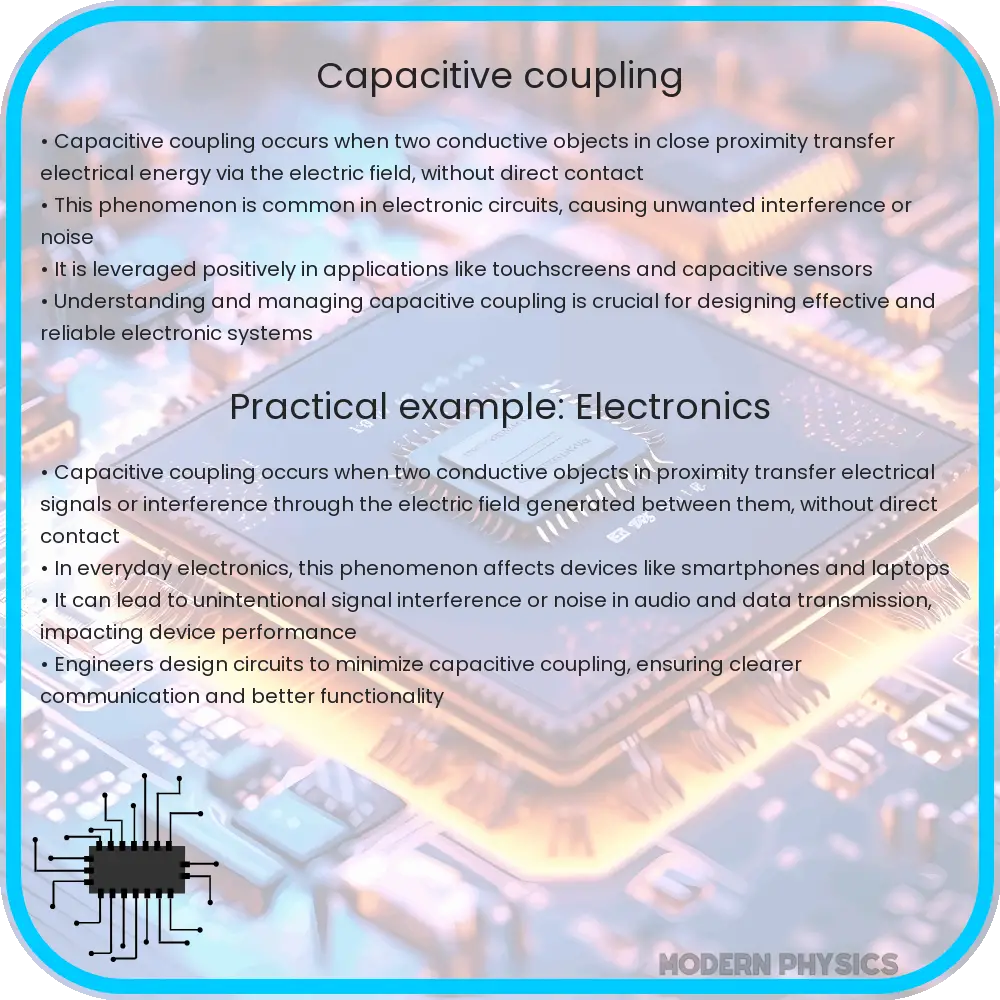Explore capacitive coupling’s efficiency, applications, and design principles in modern electronics, with insights into future advancements.

Understanding Capacitive Coupling
Capacitive coupling is a fundamental concept in electronics, where an electrical signal is transferred by means of the capacitance between circuit nodes. This phenomenon is widely utilized in various applications, ranging from radio frequency (RF) circuits to everyday electronics. The efficiency, uses, and design principles of capacitive coupling are crucial for optimizing electronic designs for better performance and reliability.
Efficiency of Capacitive Coupling
The efficiency of capacitive coupling is primarily determined by the capacitance between the conductive parts and the frequency of the signal. High-frequency signals are more efficiently coupled due to the capacitive reactance (Xc), which decreases with increasing frequency. The formula for capacitive reactance is given by Xc = 1/(2πfC), where f is the frequency and C is the capacitance. For efficient coupling, minimizing energy loss and maximizing signal transfer is essential, which can be achieved through careful design and material selection.
Uses of Capacitive Coupling
Capacitive coupling finds its applications in various fields. One of the most common uses is in the transmission of RF signals in antennas, where it helps in the efficient transfer of signals. It is also used in analog circuits, audio equipment, and in the isolation of different sections of electronic circuits. In digital electronics, capacitive coupling is used to transmit signals without a direct electrical connection, thereby preventing DC interference and allowing for AC signal transmission.
Design Principles
- Material Selection: The choice of dielectric material between the conductive plates affects the capacitance and, thus, the coupling efficiency.
- Plate Area and Distance: Larger plate areas and smaller distances between them increase the capacitance, enhancing the coupling efficiency.
- Frequency Considerations: Designing for the specific frequency range of operation is vital to ensure efficient signal transfer.
- Minimizing Interference: Proper shielding and grounding techniques are essential to reduce noise and interference in capacitive coupling.
By understanding and applying these principles, engineers can design circuits with optimized capacitive coupling, ensuring effective signal transmission and overall circuit performance.
Advanced Applications and Challenges
Capacitive coupling extends beyond basic electronic applications. In advanced technology fields like medical imaging and wireless power transfer, capacitive coupling plays a pivotal role. For instance, in MRI machines, capacitive coupling is essential for signal transmission within the complex imaging system. In wireless charging, it enables the transfer of power over a small gap without physical connections, a concept rapidly gaining popularity in consumer electronics.
Despite its widespread use, capacitive coupling presents certain challenges. One significant issue is the unintended coupling between components in densely packed circuits, leading to crosstalk and potential interference. Engineers must carefully design circuit layouts to minimize such unwanted effects. Additionally, environmental factors like temperature and humidity can impact the performance of capacitive coupling, necessitating robust and adaptable designs.
Future Prospects
Looking ahead, the evolution of capacitive coupling is closely tied to advancements in material science and nanotechnology. The development of new dielectric materials with higher permittivity and lower losses could significantly enhance coupling efficiency. Nanotechnology offers the potential for miniaturization of components, allowing for more compact and efficient designs, particularly important in the burgeoning field of wearable technology.
Conclusion
Capacitive coupling is a cornerstone of modern electronics, with its principles playing a critical role in a wide array of applications. Its efficiency hinges on factors like frequency, material selection, and design intricacies. While it offers numerous advantages, challenges such as unintended crosstalk and environmental sensitivities must be addressed. The future of capacitive coupling is bright, with emerging technologies promising even greater efficiency and miniaturization. As the demand for more sophisticated electronic devices grows, understanding and leveraging the nuances of capacitive coupling will be more important than ever for innovators and engineers alike.
